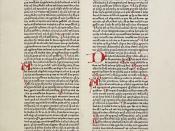St. Thomas Aquinas realized that those who doubted the existence of God did so because to them logic could not explain God's existence. So he decided to take up the task of attempting to prove through logic alone that God must exist. In one of his major works, Summa Theologiae, he offers five proofs in defense of God's existence, two of which are based on logic and observation of nature in proving God's existence to those who could not accept God on faith alone.
Aquinas' first argument is based on motion, and he believes it to be the simplest way of proving God's existence. This first argument, the argument from motion, tries to prove the existence of God as the first mover which is unmoved. Now, it is certain as a matter of human senses that some things in this world are in motion. Whatever is in motion, Aquinas states, is moved by something else.
Aquinas then defines one type of motion as the reduction of something from potentiality to actuality, and says that nothing can make this movement except by something that is already in actuality in the same respect as the first object is in potentiality. For example, something which is actually hot, like fire, makes something which is potentially hot, like wood, to be actually hot. In this way the fire moves and alters the wood. Now, it is not possible for the same thing to be, at the same time and same respect, in actuality and in potentiality. For instance, what is actually hot cannot simultaneously be potentially hot, though it may simultaneously be potentially cold. So, it is impossible that in the same respect and same manner anything should be both mover and moved. In this, Aquinas means that nothing can move itself.


